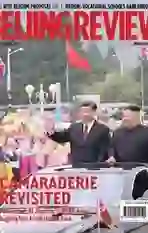Three Relationships Must Be Balanced to Expand Domestic Demand
2019-07-09
The slower expansion of domestic demand has put pressure on economic growth as the Chinese economy enters a new normal stage. Since the industrial structure can only be effectively upgraded through appropriately expanding aggregate demand, three relationships must be balanced:
Economic aggregate and economic structure
The policies on the economic aggregate and the economic structure must be balanced in order to create a favorable macro policy environment. This means the short-term policy and the mid- and long-term policies need to be coordinated.
The structural effect of the macroeconomic policy has to be strengthened and a long-term period must be allotted since the upgrading of the industrial structure is a medium- to long-term process. The government should try to maintain stability and avoid random fi scal or credit policies during a long enough period to maintain the stability and continuity of policies.
Also, if regional and urban-rural gaps cannot be narrowed, the upgrading of the industrial structure, and even steady economic growth, will be hindered. Based on coordinating the entire national market, the government should nurture the markets in central and western regio ns as well as in rural areas and boost economic development in these areas.
Stable growth and fi nancial risks
Ensuring stable growth and controlling financial risks should be balanced so that the upgrading of the industrial structure can be carried out in a stable economic environment.
To address the pressure on the domestic economy, the government has issued a number of monetary, fiscal, investment, consumption and real estate policies to ensure stable growth, leading to higher leverage rates for the government, businesses and households and stimulating expansion of the fi nancial sector. During this process, debt and fi nancial risks have been accumulating. As a result, Chinas leadership has repeatedly emphasized forestalling systemic fi nancial risks and has regarded preventing and defusing fi nancial risks as one of its top priorities.
In the next few years, China must continue to ensure stable growth and control financial risks. But these two tasks may lead to some conflicts because ensuring stable growth requires a comparatively relaxed monetary and credit policy, while controlling fi nancial risks requires a tightening of monetary and credit supply. The government must balance the relationship between maintaining reasonable liquidity and reducing financing costs on the one hand and guiding capital flows and improving fi nancial supervision on the other hand.
Domestic policy and international
environment China must coordinate well between the orientation of domestic macro policy and changes in the international policy environ- ment in order to alleviate negative impacts from external changes.
In the next few years, the international policy environment will become even more complicated. For instance, the policy orientation of the United States will be more diversifi ed, with contradictory monetary and fi scal policies, which will lead to more uncertainties. U.S. policies on raising interest rates, cutting taxes and expanding infrastructure investment, as well as its protectionist policies, will have global repercussions that may affect Chinas macro policy, its domestic economic operations and the upgrading of its industrial structure.
China must pay attention to the influence from the international policy environment and work to adopt suitable measures. Regarding U.S. interest rate hikes, China should maintain the stability and continuity of its monetary policy and keep the benchmark interest rate and renminbi exchange rate at a reasonable level. In terms of the impact from U.S. tax cuts, China should continue its policy of cutting taxes, reducing administrative fees and alleviating corporate burden. To cope with U.S. trade protectionism, China must continue to promote economic globalization, work to gain support from and cooperation with more countries and adopt more fl exible and diversifi ed foreign trade policies, making the most of international cooperation under the Belt and Road Initiative.
In addition, China must turn challenges from changes in the international policy environment into opportunities to promote the innovative development of domestic businesses, readjust its foreign trade structure and expand outbound direct investment.
